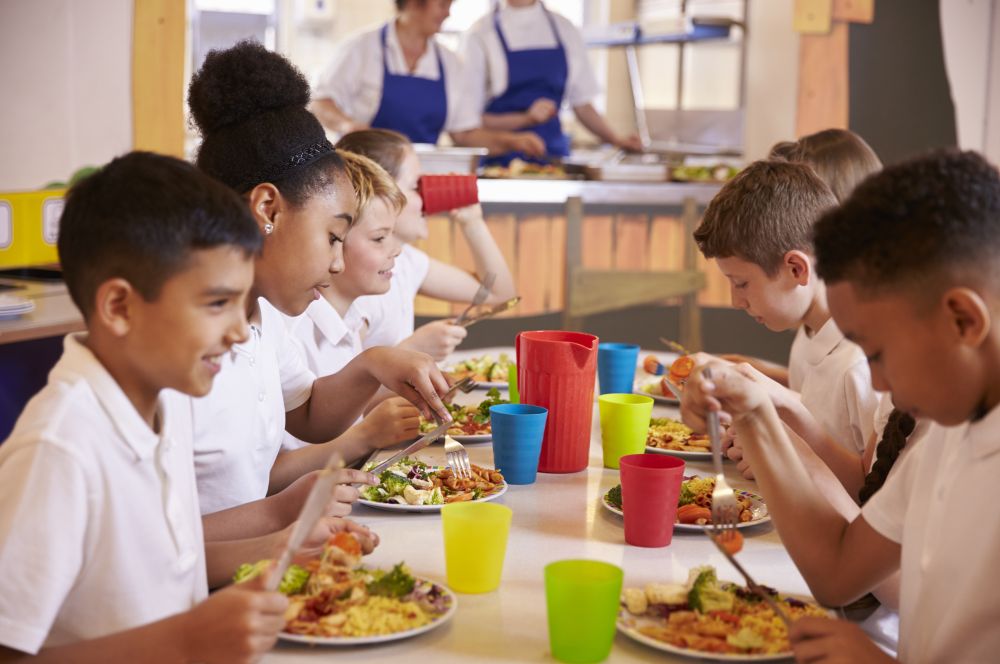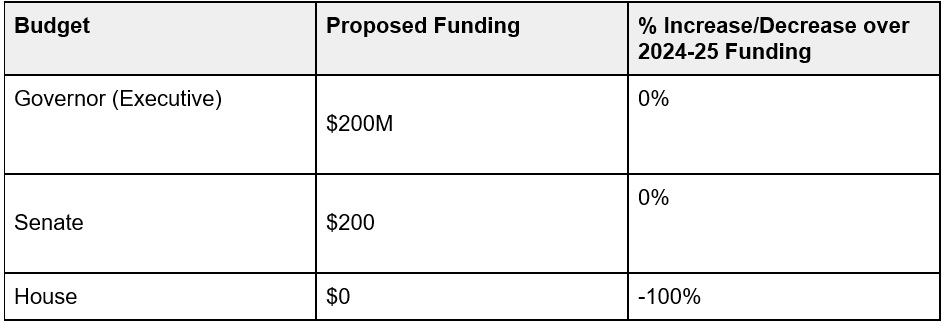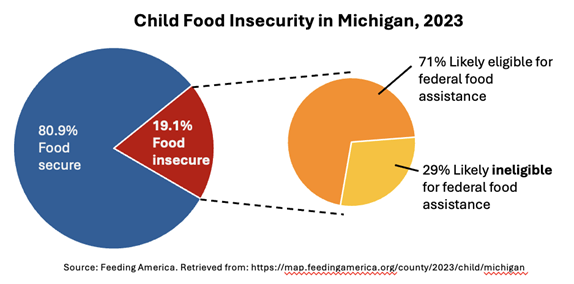A Call to Advocates: Time to speak up for the Michigan School Meals Program
By Stephen Wallace & Dr. Heather Bomsta
(September 8, 2025) – Hungry kids don’t learn well. They can’t focus well; even most adults struggle with focusing on an empty stomach. Sometimes kids get “hangry” – a made-up word for a state of feeling angry solely due to hunger, which passes once the hunger is addressed. This can lead to behavior problems, though most kids just disengage and suffer in silence. Providing school meals to all school children improves academic performance, classroom behavior, attendance, and long-term physical and mental health.1

For the past two school years,2 in an effort to tackle child hunger, Michigan has provided free breakfast and lunch to all public school students from pre-K through 12th grade, regardless of family income. More than 1.4 million Michigan students have been served by the program every year since its start.3 The Michigan School Meals program continued universal free meals provided with federal funding during the pandemic; Michigan was one of eight states that chose to invest to continue to provide free meals.4
School meals aren’t just good for kids, they’re a smart investment for everyone. A recent evaluation found that the $18.7 billion our country spends each year on school meal programs generates nearly $40 billion in health and economic benefits. That means for every single dollar we put into feeding kids, society gets back more than two dollars in return—a payoff any investor would be thrilled about.5
Our state’s investment is paying off. In just two years:
 Schools have seen a 63% increase in breakfast participation and a 69% increase in lunches served.(MI Dept. of Education, 2025) 6
Schools have seen a 63% increase in breakfast participation and a 69% increase in lunches served.(MI Dept. of Education, 2025) 6
 The average Michigan family of four has saved up to $850 per year, easing the financial burden on both low- and middle-income households.7
The average Michigan family of four has saved up to $850 per year, easing the financial burden on both low- and middle-income households.7
 Universal meals eliminate stigma. Every child eats the same meals in the same lunch line. No application, no separation – just a healthier, more equitable learning environment.
Universal meals eliminate stigma. Every child eats the same meals in the same lunch line. No application, no separation – just a healthier, more equitable learning environment.
 Local stores and farmers see economic benefits as schools use these funds to buy food from local stores and farmers.
Local stores and farmers see economic benefits as schools use these funds to buy food from local stores and farmers.
Michigan’s School Meal program is facing longer-term threats from SNAP changes and cuts at federal level, and short-term threats at the state level. We’ll address the longer-term threats first briefly, and then focus on the current threats to the program at the state level.
Longer-term Threats to the Michigan School Meals Program
Recent federal budget cuts could significantly alter the funding formula behind Michigan’s program. The federal budget reconciliation bill passed in July – and voted for by all of Michigan’s Republican members – cut SNAP benefits and will shift more costs to states. Under the new law, starting 2028 Michigan will have to cover between 5% to 22.5% of SNAP food benefit costs,8 up from 0% today.9
The new law also requires Michigan to reinstate work requirements in 2026 for parents with children age 14 and up.10 Many questions remain about work requirements and how they will be implemented, but as SNAP benefits flow through parents to children – bureaucratic errors, or an inability to meet work requirements could result in families losing SNAP benefits for months at a time. If eligibility changes and work requirements lower SNAP enrollment in Michigan, fewer schools will meet the federal threshold to qualify for the Community Eligibility Provision (CEP). CEP allows schools in high-poverty areas to offer free meals to all students without collecting applications. Losing CEP status would mean schools must either return to individual income-based applications or absorb higher meal costs.
Districts that currently qualify for CEP could lose that status if fewer families qualify for SNAP. This would require districts to either fund meals locally or reinstate income-based paperwork systems. Both scenarios create administrative burdens for families and schools, and increase the risk of children being left out. Districts that don’t qualify for CEP, but currently offer free meals thanks to state support would likely have to end that coverage entirely.11
Near-term Threats to the Michigan School Meals Program
Now let’s talk about the current threat to school meal funding at the state level. Typically, Michigan has a budget in place by July 1, but this year state budget negotiations are dragging on. Funding for school meals is included in the governor’s and senate’s proposed budgets, but not in the house budget (see proposed funding across current budget proposals in the table below).
Current State Budget Proposals for School Meal Funding (as of 8/25/25)12

Current year state funding for the school meals program continues through September 30th. However, given the uncertainty over funding for the program and the lack of a K-12 budget, some school districts have already announced they will not provide free meals for students – despite guidance from the Michigan Department of Education urging districts to continue providing meals through September with the already-allocated funds.13 Other districts have informed parents that free school meals will end after September 30th if no budget is in place, and some districts are charging students for meals if they have not applied to the federal free lunch program. Parents and students alike are navigating a messy patchwork waiting for the state government to come to agreement on a budget.
Without Universal Meals, Some Michigan Kids Will Go Hungry If the state discontinues the meal program, districts will have the choice of funding meals locally (which few could), or returning to the previous system of requiring families to qualify for the federal meals program and needing to identify kids who receive free meals (with the potential for negative stigma). That makes it sound like the Michigan kids who need free meals will be taken care of, but it’s more complex than that, and here’s why:
- Mind the gap. Currently, about 1 in five Michigan kids are food insecure, meaning they don’t always have access to sufficient food and
 experience periods of hunger. Some of these kids qualify for federal food assistance programs – and some do not. At Michigan’s Children we’re very worried about the kids that don’t qualify for food assistance and wouldn’t qualify for free meals. Child hunger rates differ across the state, but in Livingston County – where the child insecurity rate in 2023 was just 8.9% overall only 48% of food-insecure kids are likely to qualify for federal food assistance programs. That means that with the Michigan School Meals program about 1,850 food-insecure kids in Livingston might go hungry all day at school.14
experience periods of hunger. Some of these kids qualify for federal food assistance programs – and some do not. At Michigan’s Children we’re very worried about the kids that don’t qualify for food assistance and wouldn’t qualify for free meals. Child hunger rates differ across the state, but in Livingston County – where the child insecurity rate in 2023 was just 8.9% overall only 48% of food-insecure kids are likely to qualify for federal food assistance programs. That means that with the Michigan School Meals program about 1,850 food-insecure kids in Livingston might go hungry all day at school.14

- Increasing economic burdens shifted to state budgets. The budget reconciliation bill shifted billions of dollars in costs for social safety-net
 programs – like Medicaid and SNAP – to states. Repercussions from that bill’s passage have already left Michigan with a $677 million funding shortfall next year (fiscal year 2025-26).15 It’s estimated that Michigan would need to find $1.1 billion dollars over the next 6 years to maintain the current level of Medicaid and SNAP benefits.16 It’s uncertain the state could afford that, especially with future revenue shortfalls caused by the massive tax cuts passed to lower tax rates for America’s wealthiest people. Michigan has had higher revenues over the last few years and was able to invest in rainy day funds – federal tax cuts for the wealthy and shifting federal costs to state budgets has ended that.
programs – like Medicaid and SNAP – to states. Repercussions from that bill’s passage have already left Michigan with a $677 million funding shortfall next year (fiscal year 2025-26).15 It’s estimated that Michigan would need to find $1.1 billion dollars over the next 6 years to maintain the current level of Medicaid and SNAP benefits.16 It’s uncertain the state could afford that, especially with future revenue shortfalls caused by the massive tax cuts passed to lower tax rates for America’s wealthiest people. Michigan has had higher revenues over the last few years and was able to invest in rainy day funds – federal tax cuts for the wealthy and shifting federal costs to state budgets has ended that. - Shrinking benefits = increasing economic pressure on Michigan families. The federal budget reconciliation bill made changes to SNAP that
 will shrink the benefit for families, and it wasn’t generous to begin with. Currently, the average Michigan SNAP recipient with children receives $474 a month or $173 per household member.17 Anyone who has been in a grocery store recently can appreciate that it isn’t enough to feed a family. Between shrinking benefits, rising grocery prices and lagging wages, more Michigan families are going to be at risk of food insecurity and more kids are likely to go to school hungry and stay that way (or more kids will be absent as the thought of a long, challenging school day without food isn’t going to get kids out of bed). And child food insecurity is likely to hit harder in rural areas, where there are fewer food banks, fewer employment opportunities to meet work requirements and/or pay for groceries, and longer distances (transportation challenges) to get to and from employment.
will shrink the benefit for families, and it wasn’t generous to begin with. Currently, the average Michigan SNAP recipient with children receives $474 a month or $173 per household member.17 Anyone who has been in a grocery store recently can appreciate that it isn’t enough to feed a family. Between shrinking benefits, rising grocery prices and lagging wages, more Michigan families are going to be at risk of food insecurity and more kids are likely to go to school hungry and stay that way (or more kids will be absent as the thought of a long, challenging school day without food isn’t going to get kids out of bed). And child food insecurity is likely to hit harder in rural areas, where there are fewer food banks, fewer employment opportunities to meet work requirements and/or pay for groceries, and longer distances (transportation challenges) to get to and from employment.
In 2023 Michigan had 402,680 food-insecure kids, almost 30% of whom likely would not qualify for federal food assistance.18 That’s more than 120,000 Michigan kids who really need a hot breakfast and a good lunch. With shrinking assistance, increasing barriers to food assistance programs that will come into force in the next few years, and rising food costs – Michigan kids need universal school meals. Universal school meals help Michigan kids now, and the importance of the program is likely to grow. Hungry kids can’t learn and Michigan needs to keep investing in kids if we want future Michiganders to be healthy and educated.
What You Can Do
-
Contact your Michigan legislators and let them know that you want them to preserve the funding for the Michigan School Meals Program!
-
Send an email! Several groups are advocating for the School Meals Program and we encourage you to participate in all of them!
-
You can find the Michigan Chapter of the American Heart Association and their partners in the Michigan Healthy School Meals for All Coalition (including Michigan’s Children) action campaign here: https://midwestregion.quorum.us/campaign/127352/
-
The Michigan Parent Alliance for Safe Schools also has a letter to the Governor and legislators to support an education budget with funding for universal school meals – find it here.
-
Send a letter and make a call to show your support for the ‘10 cents a meal for Michigan’s kids and farms’ program here!
-
-
-
-
CALL your legislators! It isn’t everyone’s favorite activity, but it can be more impactful than just sending a mass email, and it literally takes less than a minute. Often legislators have an automated system and you can just leave a message – include your name, the city and county you live in and tell them you want them to fund universal school meals. Honestly, it’s that simple. Find your legislator’s office numbers here: https://house.mi.gov/
-
-
Get involved and keep tabs on what’s happening on school meals. After Labor Day, budget negotiations (hopefully) will speed up and we may need your support to preserve universal school meals for Michigan kids! Here are some easy ways for busy parents and child advocates to stay up-to-date:
-
Sign up for Michigan’s Children’s e-bulletin here: https://www.michiganschildren.org/michigan-children-e-bulletin/
-
Follow Michigan’s Children on social media: https://linktr.ee/MIChildren
-
Sign up for updates from the Healthy School Meals for All Coalition and share your story of how school meals have impacted your loved ones.
-
Follow the Michigan Parent Alliance for Safe Schools on Facebook for updates on their campaign: https://www.facebook.com/teammipass
-
Free school meals are one of Michigan’s smartest, most cost-effective investments.19 With children’s health, academic success, and family stability on the line, now is not the time to step backward.
- Food Research & Action Center. June 2021. Healthy School Meals for All. Retrieved from https://frac.org/healthy-school-meals-for-all
- Since 2023-24 school year
- Michigan State University Extension. (February 14, 2024). Michigan continues to invest in kids with free school meals for all. Michigan State University Extension. Retrieved from: https://www.canr.msu.edu/news/michigan-continues-to-invest-in-kids-with-free-school-meals-for-all
- Michigan’s FY24 investment was $190M and FY25 was $200M; Citizen’s Research Council of Michigan. (June 17, 2025). “With SNAP and Medicaid in D.C.’s Crosshairs, Michigan’s Universal School Meals Program May Become More Costly as a Result.” Retrieved from: https://crcmich.org/with-snap-and-medicaid-in-d-c-s-crosshairs-michigans-universal-school-meals-program-may-become-more-costly-as-a-result
- Cohen-Cline, N. (2021, November 17). Increasing investment in school meals pays for itself, and then some. The Rockefeller Foundation. https://www.rockefellerfoundation.org/grantee-impact-stories/increasing-investment-in-school-meals-pays-for-itself-and-then-some/
- Michigan Department of Education. (2025, May 16). Vital school food, nutrition programs at risk amid proposed federal cuts. State of Michigan. Retrieved from https://www.michigan.gov/mde/news-and-information/press-releases/2025/05/16/vital-school-food-nutrition-programs-at-risk
- MSU Extension, 2024, https://www.canr.msu.edu/news/michigan-continues-to-invest-in-kids-with-free-school-meals-for-all
- Keith-Jennings, B. (2025, July 17). SNAP cuts in the “One Big Beautiful Bill Act” leave almost 3 million young adults vulnerable. Urban Institute. https://www.urban.org/urban-wire/snap-cuts-one-big-beautiful-bill-act-leave-almost-3-million-young-adults-vulnerable
- Citizens Research Council of Michigan. (2025, June 24). With SNAP and Medicaid in D.C.’s crosshairs, Michigan’s universal school meals program may become more costly as a result. Citizens Research Council of Michigan. Retrieved from https://crcmich.org/with-snap-and-medicaid-in-d-c-s-crosshairs-michigans-universal-school-meals-program-may-become-more-costly-as-a-result
- Axelrod, T. (2025, May 28). The “big beautiful bill” treats single parents differently. Axios. Retrieved from https://www.axios.com/2025/05/28/tax-bill-snap-work-single-parents
- If you are interested in what districts qualify for CEP and nearly qualify for CEP, visit this link, https://www.michigan.gov/mde/-/media/Project/Websites/mde/Food-and-Nutrition-Programs/CEP/2025-CEP-Site-Level-Posting—reduced-size—corrected.pdf?rev=dce7f7752c6b429a86a11b8d931a7a12&hash=609452098FEC4E06A4887DF5FB4A758B
- Michigan House of Representatives, House Fiscal Agency. (2025). Public Act 4577: House-Passed School Aid appropriation summary. Lansing, MI: House Fiscal Agency. Retrieved from https://www.house.mi.gov/hfa/PDF/Summaries/25h4577h3_SchAid_Hse_Passed.pdf
- Michigan Department of Education. (2025, August 7). Michigan School Meals for School Year 2025-26 [Memorandum]. State of Michigan. Retrieved from https://www.michigan.gov/mde/-/media/Project/Websites/mde/Memos/2025/08/Michigan-School-Meals.pdf
- Feeding America. 2023 Food Insecurity Among Children in Livingston County, MI.https://map.feedingamerica.org/county/2023/child/michigan/county/livingston
- Citizens Research Council of Michigan. (2025). The “One Big Beautiful Bill Act” and its impact on Michigan’s budget. Citizens Research Council of Michigan. Retrieved from https://crcmich.org/publications/the-one-big-beautiful-bill-act-and-its-impact-on-michigans-budget
- Citizens Research Council of Michigan. (2025). The “One Big Beautiful Bill Act” and its impact on Michigan’s budget. Citizens Research Council of Michigan. Retrieved from https://crcmich.org/publications/the-one-big-beautiful-bill-act-and-its-impact-on-michigans-budget
- Center on Budget and Policy Priorities. (2024, November). SNAP in Michigan: Factsheet. Retrieved from https://www.cbpp.org/sites/default/files/atoms/files/snap_factsheet_michigan.pdf
- Feeding America. 2023 Food Insecurity Among Children in Michigan. https://map.feedingamerica.org/county/2023/child/michigan
- Cassidy, J. (2025, May 9). Fighting hunger with school meals. Michigan League for Public Policy. Retrieved from https://mlpp.org/fighting-hunger-with-school-meals/
